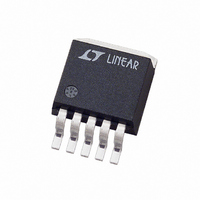LT3080EQ#TRPBF Linear Technology, LT3080EQ#TRPBF Datasheet - Page 9

LT3080EQ#TRPBF
Manufacturer Part Number
LT3080EQ#TRPBF
Description
IC REG LDO ADJ 1.1A 5-DDPAK
Manufacturer
Linear Technology
Datasheet
1.LT3080ESTTRPBF.pdf
(26 pages)
Specifications of LT3080EQ#TRPBF
Regulator Topology
Positive Adjustable
Voltage - Output
0 ~ 36 V
Voltage - Input
1.2 ~ 36 V
Voltage - Dropout (typical)
1.35V @ 1.1A
Number Of Regulators
1
Current - Output
1.1A
Current - Limit (min)
1.1A
Operating Temperature
-40°C ~ 125°C
Mounting Type
Surface Mount
Package / Case
TO-263-5, D²Pak (5 leads + Tab), TO-263BA
Lead Free Status / RoHS Status
Lead free / RoHS Compliant
Available stocks
Company
Part Number
Manufacturer
Quantity
Price
APPLICATIONS INFORMATION
Output Voltage
The LT3080 generates a 10μA reference current that fl ows
out of the SET pin. Connecting a resistor from SET to
ground generates a voltage that becomes the reference
point for the error amplifi er (see Figure 1). The reference
voltage is a straight multiplication of the SET pin current
and the value of the resistor. Any voltage can be generated
and there is no minimum output voltage for the regulator.
A minimum load current of 1mA is required to maintain
regulation regardless of output voltage. For true zero
voltage output operation, this 1mA load current must be
returned to a negative supply voltage.
With the low level current used to generate the reference
voltage, leakage paths to or from the SET pin can create
errors in the reference and output voltages. High quality
insulation should be used (e.g., Tefl on, Kel-F); cleaning
of all insulating surfaces to remove fl uxes and other resi-
dues will probably be required. Surface coating may be
necessary to provide a moisture barrier in high humidity
environments.
Board leakage can be minimized by encircling the SET
pin and circuitry with a guard ring operated at a potential
close to itself; the guard ring should be tied to the OUT
pin. Guarding both sides of the circuit board is required.
Bulk leakage reduction depends on the guard ring width.
Ten nanoamperes of leakage into or out of the SET pin and
associated circuitry creates a 0.1% error in the reference
voltage. Leakages of this magnitude, coupled with other
sources of leakage, can cause signifi cant offset voltage
and reference drift, especially over the possible operating
temperature range.
+
V
IN
Figure 1. Basic Adjustable Regulator
+
V
V
CONTROL
CONTROL
IN
SET
R
SET
LT3080
+
–
C
SET
OUT
3080 F01
V
C
OUT
OUT
If guardring techniques are used, this bootstraps any
stray capacitance at the SET pin. Since the SET pin is
a high impedance node, unwanted signals may couple
into the SET pin and cause erratic behavior. This will
be most noticeable when operating with minimum
output capacitors at full load current. The easiest way
to remedy this is to bypass the SET pin with a small
amount of capacitance from SET to ground, 10pF to
20pF is suffi cient.
Stability and Output Capacitance
The LT3080 requires an output capacitor for stability. It
is designed to be stable with most low ESR capacitors
(typically ceramic, tantalum or low ESR electrolytic).
A minimum output capacitor of 2.2μF with an ESR of 0.5Ω
or less is recommended to prevent oscillations. Larger
values of output capacitance decrease peak deviations
and provide improved transient response for larger load
current changes. Bypass capacitors, used to decouple
individual components powered by the LT3080, increase
the effective output capacitor value.
For improvement in transient performance, place a capaci-
tor across the voltage setting resistor. Capacitors up to
1μF can be used. This bypass capacitor reduces system
noise as well, but start-up time is proportional to the time
constant of the voltage setting resistor (R
and SET pin bypass capacitor.
Extra consideration must be given to the use of ceramic
capacitors. Ceramic capacitors are manufactured with a
variety of dielectrics, each with different behavior across
temperature and applied voltage. The most common
dielectrics used are specifi ed with EIA temperature char-
acteristic codes of Z5U, Y5V, X5R and X7R. The Z5U and
Y5V dielectrics are good for providing high capacitances
in a small package, but they tend to have strong volt-
age and temperature coeffi cients as shown in Figures 2
and 3. When used with a 5V regulator, a 16V 10μF Y5V
capacitor can exhibit an effective value as low as 1μF to
2μF for the DC bias voltage applied and over the operating
temperature range. The X5R and X7R dielectrics result in
more stable characteristics and are more suitable for use
as the output capacitor. The X7R type has better stability
across temperature, while the X5R is less expensive and is
SET
LT3080
in Figure 1)
3080fb
9














